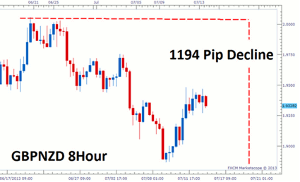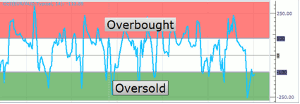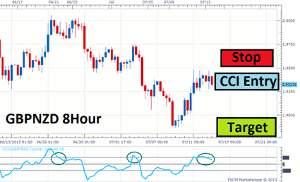This currency pair has declined over 1194 pips in the last month, writes Walker England of DailyFX.com, and as they retrace, learn to trade market swings with the CCI indicator.
Trend traders in the forex market look to identify market direction prior to entering into a trade. However, price rarely moves in one singular direction, so this task can be more difficult than it seems. For savvy traders, these counter trend moves, can often allow entries into an established market at a better price. Today, we will review trading these market swings and learn how to identify an entry when momentum swings back into the direction of the primary trend.
Below we can see an example of the GBP/NZD eight-hour chart trending lower over the last month. Even though price has declined as much as 1194 pips, notice how it has not been a one way directional move. Along the way, there have been many opportunities to find new selling opportunities as the market provides a short term rally. So how can we better identify these chances to trade?
GBP/NZD Trend

(Created using FXCM’s Marketscope 2.0 charts)
Click
to Enlarge
To time our entry into a trade, a technical indicator such as an oscillator is often used. When a market is in a downtrend, traders can wait for an indicator to become overbought. Overbought describes a scenario where the market may be overvalued causing an indicator to reach its upper bounds. Below we can see the commodity channel index (CCI), which is very similar to other oscillators, such as RSI, or stochastics.
Pictured below, we can see that above the +100 value is considered overbought while below the -100 value is considered oversold. The key is to timing new our entries on the GBP/NZD will when momentum returns to the downside. This means traders should wait for the indicator to close back under +100 while momentum resumes moving lower. With this in mind, now let’s return to our GBP/NZD graph.
CCI Overbought / Oversold
Below we again can see our GBP/NZD eight-hour chart previously mentioned, but this time we have included the CCI indicator. You will notice that there have been a total of four opportunities to sell the pair as momentum returned lower. The key is to time your entry as CCI moves back below +100 indicating the conclusion of our short-term rally with momentum returning to the markets longer standing trend.
GBP/NZD CCI Entries
As with any strategy, managing risk is a high priority. One way to manage risk is to place a stop order over the previous swing high. This way, in the event that our downtrend is concluded we can exit any positions to sell at their first convenience.
By Walker England, Trading Instructor, DailyFX.com




















